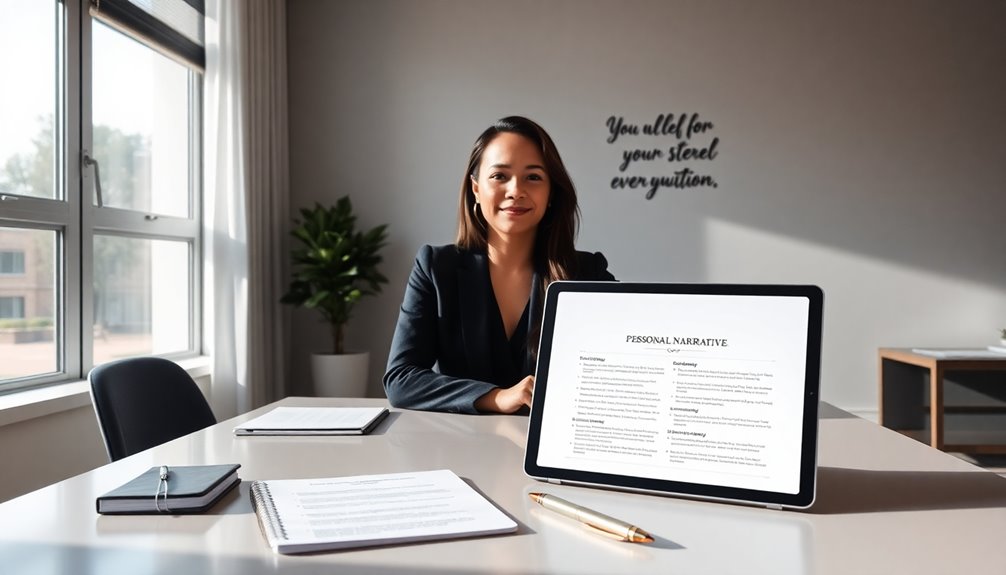When you answer "Tell me about yourself," remember it sets the interview's tone. Start with a concise log line that aligns your skills with the job description. Highlight 2-3 key accomplishments using quantifiable metrics, showing how you tackle challenges. Tell your professional story chronologically to create clarity and engage the interviewer. Don't just speak—invite questions and allow moments of silence for deeper interaction. Remember, your response can make or break the first impression; 72% of candidates miss their chance by not impressing. Keep going, and you'll discover even more strategies to refine your interview skills.
Key Takeaways
- Start with a tailored log line that summarizes your professional identity and aligns with the job description in one to two sentences.
- Highlight 2-3 quantifiable achievements that demonstrate your problem-solving abilities and directly relate to the key responsibilities of the role.
- Use the STAR method to structure your responses, clearly outlining your specific contributions to past projects or initiatives.
- Engage the interviewer by inviting questions and leaving brief silences after your responses for deeper dialogue.
- Practice delivering your narrative confidently, ensuring it flows chronologically and emphasizes your readiness to contribute to the organization.
The Power of First Impressions

When it comes to job interviews, nailing that first impression can set you apart from the competition. Research shows that 72% of candidates who don't receive job offers fail to make a great impression. So, how do you guarantee you're not one of them? The initial question "Tell me about yourself" is essential. How you answer this question not only sets the tone for the interview but also shapes the interviewer's perception of you.
Prepare a concise and engaging response that highlights your skills, experiences, and what makes you a great fit for the role. Remember, interviewers often review resumes right before meeting you, so they'll be looking to see how well you align with the job requirements. To create a more dynamic conversation, consider inviting the interviewer to share their interests as well. This can foster a connection and enhance the overall impression you leave.
Lastly, don't underestimate the power of silence. After asking questions, give your interviewer time to process their thoughts. This approach can lead to more meaningful interactions, helping you solidify that all-important first impression.
Analyzing Job Descriptions

When you analyze job descriptions, you'll uncover the specific business needs and key responsibilities the employer highlights. This understanding helps you tailor your responses to show how your skills and experiences align with what they're looking for. By addressing these points, you can effectively demonstrate your value during the interview.
Understanding Business Needs
| Job Description Element | Business Need |
|---|---|
| Customer inquiries management | Improve client satisfaction |
| Data analysis | Enhance operational efficiency |
| Team collaboration | Foster innovation |
| Problem resolution | Increase service reliability |
When you identify these needs, you can effectively highlight your past experiences that resonate with the job description. Even if you lack direct experience, showcasing relevant achievements can demonstrate your problem-solving skills. This way, you present your qualifications in a manner that aligns with the company's objectives. Understanding the business perspective not only enhances your appeal during interviews but also positions you as a candidate who truly understands what the organization aims to achieve.
Identifying Key Responsibilities
Understanding business needs sets the stage for the next step: identifying key responsibilities in job descriptions. When you analyze a job description, you uncover specific challenges the role is meant to address. This insight helps you prepare for potential interview questions and tailor your responses effectively. To do this, make sure you focus on the following:
- Highlight Key Responsibilities: Identify what the employer emphasizes as essential tasks, noting specific skills required.
- Analyze Challenges: Look for any problems the organization faces that the role aims to solve, which can guide your examples.
- Connect Your Experience: Relate your past achievements to these responsibilities, showcasing your problem-solving abilities.
- Align with Organizational Goals: Understand how the responsibilities fit into the company's objectives, allowing you to present your qualifications in context. Additionally, recognizing the importance of content quality can enhance your ability to communicate effectively during the interview process.
Tailoring Your Responses
Tailor your responses by closely examining the job description to uncover what the employer truly values. Take inventory of the responsibilities and challenges listed; these clues can help you align your experiences with their needs. For instance, if the role emphasizes managing customer complaints, be ready to share a relevant example.
Here's a quick guide to help you structure your thoughts:
| Job Requirement | Tailored Response Example |
|---|---|
| Managing customer complaints | "In my previous role, I resolved 95% of customer issues on the first call." |
| Social media marketing | "I increased engagement by 40% through targeted campaigns on social media." |
| Sales targets | "I'm interested in how my strategy led to a 30% increase in sales last year." |
Focusing on quantifiable achievements showcases your problem-solving abilities. Frame your responses to highlight how you can address the company's challenges. This strategy not only makes you memorable but positions you as a solution-focused candidate.
Crafting Your Log Line

When you kick off your job interview, a well-crafted log line can set the right tone and grab the interviewer's attention. An effective log line is a concise, impactful summary of your professional identity that showcases your background and unique skills. Here's what you need to know about crafting yours:
- Tailor It: Customize your log line to align with the specific job description, addressing the employer's needs directly.
- Highlight Accomplishments: Include quantifiable metrics, like "I increased sales by 30%," to demonstrate tangible achievements that make you stand out.
- Keep It Concise: Aim for one or two sentences that clearly convey who you are and what you bring to the table. For example, I'm a results-driven marketer with a passion for innovative strategies.
- Practice: Rehearse your log line before the interview to guarantee you communicate your value succinctly and confidently. Additionally, incorporating data-driven marketing strategies can further enhance your appeal to potential employers by showcasing your ability to leverage analytics for business growth.
Highlighting Key Accomplishments

Highlighting key accomplishments is essential for making a lasting impression during your job interview. Focus on quantifiable metrics that demonstrate your effectiveness in past roles, like "increased sales by 30% in one year." Choose 2-3 relevant accomplishments that align with the job description to showcase skills and experiences that directly meet the employer's needs.
Using the STAR method (Situation, Task, Action, Result) can help you present your accomplishments clearly. This structured approach makes it easier for the interviewer to understand and remember your achievements. For instance, you might relate a specific accomplishment to a challenge you faced, illustrating your problem-solving abilities and adaptability.
Incorporate details about specific projects or initiatives, such as "led a marketing campaign that generated 500 new leads." This adds credibility to your narrative and captivates the interviewer's interest. Remember, the goal is to paint a vivid picture of your past successes, showing how they prepare you for the role you're applying for. By emphasizing these accomplishments, you not only highlight your qualifications but also demonstrate your readiness to contribute to the organization's success.
Structuring Your Narrative

A well-structured narrative can greatly enhance your job interview performance. Begin with a strong log line that encapsulates your professional identity and unique value in one sentence, like "Results-driven marketer with a passion for impactful campaigns." This grabs the interviewer's attention right away.
Next, structure your narrative chronologically, focusing on 2-3 relevant accomplishments that align with the job description. Highlighting quantifiable metrics, such as "increased social media engagement by 30%," provides concrete evidence of your success.
Follow these steps to create an impactful narrative:
- Craft your log line: Summarize who you are and what you bring to the table.
- Outline your background: Discuss your professional journey in chronological order.
- Showcase accomplishments: Choose 2-3 key achievements that relate to the role.
- Engage the interviewer: After sharing your career aspirations, invite them to share their interests.
Practicing brief silences after your questions can encourage deeper dialogue, creating a more interactive discussion. Structuring your narrative thoughtfully not only demonstrates your qualifications but also fosters a meaningful connection.
Preparing for Common Questions

When prepping for common interview questions, you want to craft a narrative that highlights your relevant skills. Focus on how your unique experiences align with the role, making it easy for the interviewer to see your value. Don't forget to engage the interviewer by inviting them to ask follow-up questions, creating a more dynamic conversation. Incorporating examples of your emotional intelligence can further demonstrate your adaptability and team management skills during the interview.
Crafting Your Narrative
Crafting your narrative for job interviews is like setting the stage for a compelling performance. You want to captivate your audience right from the start. Begin with a compelling log line that summarizes your professional identity and unique value in one or two sentences. This sets a positive tone for the interview.
Here's a structured approach to help you craft your narrative:
- Highlight Key Accomplishments: Choose 2-3 achievements relevant to the job description. Use quantifiable metrics, like "increased sales by 15% within six months," to demonstrate your impact.
- Tailor Your Message: Align your narrative with specific business needs outlined in the job description. Show how your past experiences can offer solutions.
- Engage the Interviewer: After sharing your background, create an interactive dialogue by asking, "What would you like to learn most about me?"
- Articulate Future Aspirations: Practice a concise statement about your career goals to clearly communicate how they align with the role.
- Additionally, consider how your skills can contribute to creating a retirement savings plan for the financial well-being of employees, as it showcases your understanding of long-term goals.
Highlighting Relevant Skills
Highlighting relevant skills is essential for making a lasting impression during job interviews, especially when faced with common questions like "What are your strengths?" or "Why should we hire you?" Start by identifying the key skills outlined in the job description, then connect them to your past experiences. Craft a log line that summarizes your professional identity and unique value in one to two sentences.
Select 2-3 relevant accomplishments that highlight your skills. For instance, if you increased sales by 30% in a previous role, mention it clearly to demonstrate your effectiveness. Anticipate the interviewer's expectations by articulating your career goals and how they align with the role, showcasing your commitment to growth.
Practice your response to guarantee it addresses the specific problems outlined in the job description. This enhances your appeal as a candidate who can provide solutions. Finally, conclude your introduction with an engaging question, like "What would you like to learn most about me?" This fosters a more interactive dialogue with the interviewer, allowing you to further showcase your relevant skills and experiences.
Engaging the Interviewer
After showcasing your relevant skills, the next step is to engage the interviewer effectively, starting with the often-asked question, "Tell me about yourself." This question sets the tone for the interview, so it's important to prepare a concise and compelling response. Focus on aligning your career goals with the role you're applying for to establish a clear connection.
To enhance your engagement, consider the following strategies:
- Craft a Future Statement: Articulate your career aspirations and how they align with the company's objectives, showing your long-term interest.
- Invite Dialogue: Ask the interviewer, "What would you like to learn most about me?" This invites interaction and demonstrates your enthusiasm for the conversation.
- Embrace Silence: After posing a question, give the interviewer a moment to think. This can lead to deeper engagement and more meaningful exchanges.
- Tailor Your Responses: Reflect on the specific responsibilities outlined in the job description. Tailoring your answers shows you understand the role and can address challenges effectively.
Engaging With Interviewers

Engaging with interviewers requires a blend of confidence and strategy, especially during that pivotal first question, "Tell me about yourself." This question sets the tone for the entire conversation, so it's your chance to shine. You should share relevant professional experiences while inviting the interviewers to participate. Ask them what they'd like to know most about you; this creates a two-way dialogue.
After posing your questions, maintain a moment of silence. This gives interviewers time to process, leading to deeper engagement. Connect your past experiences to the job requirements, showing you understand the business needs highlighted in the job description. A well-crafted log line summarizing your professional identity and unique value can greatly enhance first impressions.
Here's a simple table to illustrate key points for engaging effectively:
| Strategy | Action Needed | Emotional Outcome |
|---|---|---|
| Share Relevant Experiences | Tailor your story to the role | Builds relatability |
| Pose Engaging Questions | Ask what interests them | Encourages conversation |
| Embrace Silence | Allow them to think | Fosters deeper connections |
| Connect Your Skills | Align with job requirements | Demonstrates value |
Post-Interview Strategies

After your interview, it's essential to take action that can set you apart from other candidates. Sending a thank-you note not only shows your gratitude but also reinforces your interest in the position. Additionally, reflecting on your performance and seeking networking opportunities can help you grow and prepare for future interviews.
Thank-You Notes
Often overlooked, a thank-you note can be a game-changer in your post-interview strategy. Sending one within 24 hours of your interview not only shows professionalism but also appreciation for the interviewer's time. A personalized note can greatly enhance your candidacy by reinforcing your fit for the role.
Here are four key elements to include in your thank-you note:
- Express Gratitude: Thank the interviewer for their time and for the opportunity to learn more about the company.
- Reference Specific Topics: Mention particular discussions from the interview to strengthen your connection and show you're engaged.
- Recap Your Skills: Briefly highlight your qualifications and how they align with the job to serve as a gentle reminder of your potential contributions.
- Keep Communication Open: Let them know you're looking forward to the next steps, fostering an avenue for further engagement.
Self-Reflection Techniques
Immediately following your interview, taking the time to reflect on your performance can greatly enhance your future prospects. Start by identifying your strengths during the interview. What questions did you answer confidently? Recognizing these areas can boost your self-assurance for future interviews. Next, pinpoint any moments where you felt uncertain or could have improved your responses. This self-awareness allows you to strategize better for next time.
Sending a thank-you note within 24 hours is also essential. Use this opportunity to express gratitude and reinforce your interest in the position, positively influencing the interviewer's perception of you.
Stay updated on the company and role specifics after the interview. This knowledge prepares you for informed discussions in follow-up communications, showing your ongoing interest.
Lastly, continuously enhance your skills relevant to your field. Whether it's digital marketing or data analysis, keeping your skills sharp will keep you competitive and ready for new opportunities. By reflecting on your performance, maintaining your knowledge, and honing your skills, you'll be setting yourself up for success in future interviews.
Networking Opportunities
Reflecting on your interview performance sets the stage for effective networking opportunities that can further your career. By taking strategic actions post-interview, you can enhance your connections and position yourself for future roles. Here's how to capitalize on your recent experience:
- Send a personalized thank-you note: Within 24 hours, express your gratitude to your interviewers. This shows professionalism and leaves a lasting impression.
- Leverage LinkedIn: Connect with your interviewers or other company employees. This not only keeps you in their network but can also reveal potential opportunities down the road.
- Engage on social media: Follow the company's social media channels and comment on their posts. This keeps you on their radar and demonstrates your continued interest in the organization.
- Seek informational interviews: Reach out to current employees for insights about the company culture and role. This can provide valuable knowledge that will aid in future applications.
Continuous Skill Development

Investing in continuous skill development is essential for staying competitive in today's job market. With 94% of employees stating they'd remain longer at a company that supports their learning, it's clear that organizations recognize the value of fostering growth. By engaging in regular training and professional development, you can boost your productivity by up to 30%. This not only enhances your job performance but also increases your overall job satisfaction.
Moreover, a LinkedIn report reveals that 68% of employees view continuous learning as vital for career advancement. If you aim for future opportunities, prioritizing skill enhancement is non-negotiable. Companies that invest in employee development also reap financial rewards, experiencing a 24% increase in profit.
As the World Economic Forum warns, by 2025, up to 85 million jobs may be displaced due to technological advancements. To adapt and thrive in this evolving landscape, you must commit to continuous skill development. Embrace learning as a lifelong journey, and you'll position yourself ahead of the curve, ready to seize new opportunities as they arise.
Tailoring Your Approach

Continuous skill development sets the stage for a successful job interview, where tailoring your approach can make all the difference. To effectively respond to the "Tell me about yourself" question, align your professional identity with the job requirements. Here's how you can craft a compelling introduction:
- Craft a Log Line: Summarize your professional background and unique value in a concise statement. This creates a memorable first impression.
- Highlight Key Accomplishments: Focus on 2-3 achievements that directly relate to the job description. This showcases your problem-solving skills and how you can meet the company's needs.
- Incorporate Metrics: Use quantifiable metrics in your statements, like "Increased sales by 25% in six months." This emphasizes your impact and effectiveness in previous roles.
- Encourage Dialogue: After your introduction, invite the interviewer to share their interests. This fosters a conversational dynamic, allowing for deeper engagement and connection.
Frequently Asked Questions
How Do I Answer "Tell Me About Yourself" to a Recruiter?
To answer "tell me about yourself," start with a strong log line that sums up your professional identity. Outline your career journey, emphasizing experiences that relate to the position. Use quantifiable achievements to showcase your impact, like "I increased sales by 30% in one year." Conclude by expressing your enthusiasm for the role. Finally, invite engagement by asking, "What would you like to learn most about me?" to foster a dynamic conversation.
What Is the Best Answer for Tell Me About Yourself Sample?
When answering the question, you want to blend personal and professional elements seamlessly. Start by highlighting your unique value, like being a "results-driven marketer." Then, share 2-3 key accomplishments that showcase your skills, such as boosting sales or leading successful campaigns. Wrap up by expressing your career aspirations and inviting dialogue, asking, "What would you like to learn most about me?" This approach creates a strong, engaging connection with your interviewer.
What Is the Best Answer for "Tell Me About Yourself With No Experience"?
When you lack professional experience, focus on your education and relevant coursework. Highlight any projects that reflect your skills and passion. Emphasize transferable skills gained from part-time jobs or volunteering, like communication and teamwork. Share a log line that showcases your enthusiasm, such as "Motivated recent graduate keen to learn." Connect your interests to the role, and express excitement about the opportunity to contribute and learn more about the team's goals.
How Do You Introduce Yourself in an Interview for a Recruiter Position?
In your introduction for a recruiter position, start with an engaging statistic, like "Over 70% of candidates prefer personalized communication." Then, share how you've effectively matched talent with organizational needs, highlighting successes such as filling critical roles swiftly. Mention your goal of enhancing candidate experiences and building strong teams. Finally, invite the interviewer to engage by asking, "What aspects of my experience interest you most?" This creates a conversational atmosphere and showcases your confidence.
Conclusion
In the end, mastering the art of "tell me about yourself" is like wielding a double-edged sword; it can either cut through the noise or leave you floundering. By honing your narrative and aligning it with job descriptions, you create a lasting impression. Remember, each interview is a fresh canvas. Embrace the opportunity, engage authentically, and always be ready to adapt. With practice and reflection, you'll transform your story into a powerful tool that resonates with recruiters.
Felicity, our Author, pens in-depth articles and guides that delve into the heart of personal discovery. Her narrative-driven approach weaves together theory, practice, and personal anecdotes, making the journey of self-exploration both relatable and inspiring. Felicity’s contributions help illuminate the path for those seeking a deeper understanding of themselves and their relationships.










